Question bank
Chapter-1 Cell Cycle and Cell Division
Q-1 Answer the following questions.
Q-2 Explain the following terms:
Q-3 State whether the following statements are true or false:
Q-4 Give a biological/technical term for the following:
Q-5 Column 'B' is a list of items related to ideas in Column 'A'. Match the term in Column 'B' with the suitable idea given in Column 'A'

Q-6 Determine whether the following characteristics apply to mitosis, meiosis, or both, by putting a tick mark in the appropriate column(s).
Q-7 Shown below are the stages in diploid cell division. One stage is repeated.

Q-8 Given alongside is a diagram of a double helical structure of DNA:
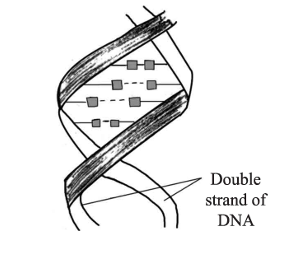
Q-9 The diagrams X and Y are part of a phenomenon that occurs in a certain type of cell division.
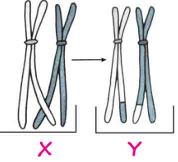
Q-10 The diagram represents a stage during mitotic cell division in an animal cell:
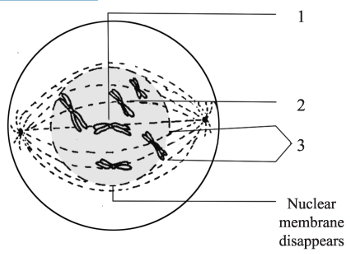
Q-11 The diagram represents the cell cycle. Match the statements given below with the appropriate letters on the diagram.

Chapter-2 Heredity: Fundamentals of Genetics
Q-1 Study the following problems based on crosses involving a single trait and complete the given squares and answer the questions.



Q-2
In blood typing the gene for type A and the gene for type B are codominant. The gene for type 0 is recessive. Complete the following squares and determine the possible blood types of the offspring when:
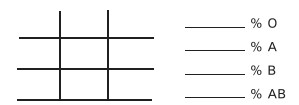

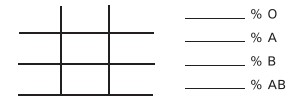

Q-3 Explain the following terms:
Q-4 Distinguish between:
Q-5 Answer the following questions.
(2) (i) Name the Austrian monk who formulated the basic laws of inheritance. (ii) Name and state the two laws formulated by the botanist named in (i).
(8) Explain why it is possible for brown eyed parents to have a blue eyed child. Which law does it illustrate?
Q-6 A homozygous plant having round [R] and yellow [Y] seed is crossed with a homozygous plant which has wrinkled [r] and green [y] seeds:
Q-7 Give one term for the following:
Q-8 State whether the following statements are true or false. Correct the incorrect statements.
Q-9 The diagram shows the sex chromosomes of a human couple A and B, and four of their children, C, D, E and F.
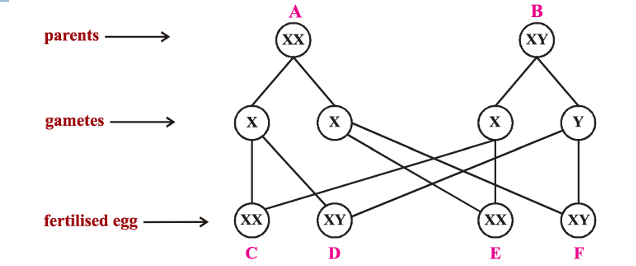
Q-10 The gene (allele) b for colour blindness is recessive to the gene B for normal vision. The gene b is carried only on the X chromosome.
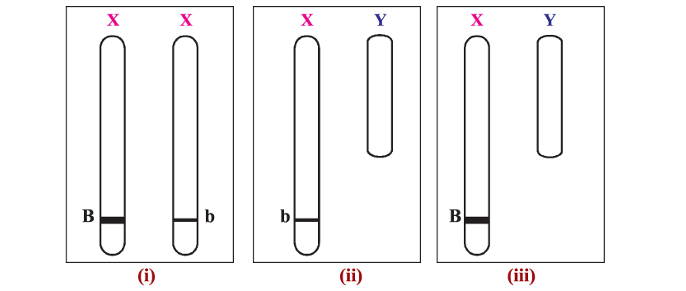
Q-11
In bees, wasps and ants, an unfertilised egg (n) develops into a male and a fertilised egg (2n) into a female.
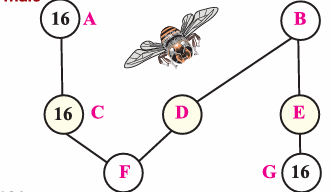
Multiple Choice Questions
Q-1 Which of the following depict monohybrid ratio:
(i)
1 : 2 : 1(ii)
1 : 1(iii)
3 : 1(iv)
1 : 3(v)
none of theseQ-2 Which of the following depict dihybrid ratio:
(i)
9 : 5: 1(ii)
9 : 3 : 3 : 1(iii)
9 :7(iv)
9: 4 :3(v)
none of theseQ-3 RR (red) is crossed with rr (white). All the Rr offsprings are pink. This is an indication that R gene is
(i)
Hybrid(ii)
Recessive(iii)
Incompletely dominant(iv)
MutantQ-4 A true breeding tall and smooth-seeded pea plant is crossed with a true breeding dwarf and wrinkled seeded plant. The fact that F1 plants were all tall demonstrates:
(i)
Principle of independent assortment of characters.(ii)
That recombination of characters appears in F 2 generation.(iii)
That P1 tall plants were heterozygous.(iv)
That tallness was dominant to dwarfness.Q-5 How many genes does a child receive from its father?
(i)
25%(ii)
50%(iii)
75%(iv)
100%Q-6 Law of independent assortment can be proved on the basis of which of the following ratios:
(i)
3 : 1(ii)
2 : 1 : 1(iii)
9 : 3: 3: 1(iv)
2 : 1
Q-7 After crossing a tall pea plant with a dwarf pea plant, all the offsprings were tall. If one of these new tall pea plants is crossed with a dwarf plant, the ratio of tall to dwarf in the next generation would be:
(i)
1 tall : 1 dwarf(ii)
3 tall : 1 dwarf(iii)
All tall(iv)
All dwarfChapter-3 Osmosis and Ascent of Sap
Q-1 State whether the following statements are true or false:
Q-2 Complete the following sentences by choosing the correct option from the brackets.
Q-3 Fill in the blanks
(v) The unassisted movement of solutes from a region of higher to lower concentration is called _________________
Q-4 Give the biological term/technical term for the following:
Q-5 Show with the help of neat sketches how a red blood cell would appear if placed in each of the following separately:
Q-6 Differentiate between:
Q-7 Name the process/phenomenon:
Q-8 Give reasons:
Q-9
The figure represents a root hair.
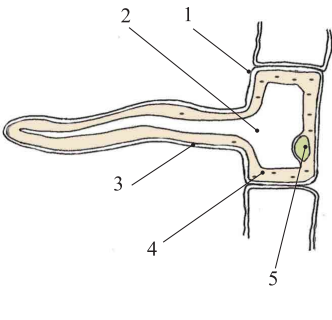
Q-10 A complete ring of bark removed from a tree in spring. The tree continued to live through summer but a swelling appeared on the bark above ring while the bark below shrivelled up.
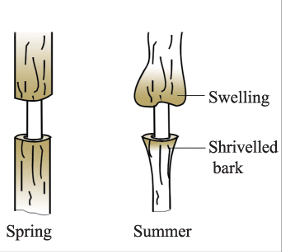
Q-11 An experiment was set up with a raw potato.
The skin of the tuber was removed and slices were taken off from all sides giving it the shape of a square block. The central portion was scooped out to form a cup. Strong sugar solution was put in the cup and the liquid level was marked by inserting a pin. The whole potato block was put in a dish containing water coloured with a drop of ink.
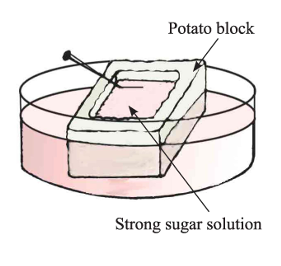
Q-12 Experiment:
A thin strip of epidermal cells from the fleshy scales of an onion bulb was exam- ined in a drop of water under a microscope.The cells appeared as shown in the figure alongside. The thin strip was then transferred to a drop of strong sugar solution and re-examined under the microscope after about five minutes.
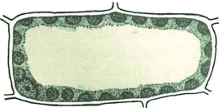
Q-13 Study the diagram given alongside and answer the questions:
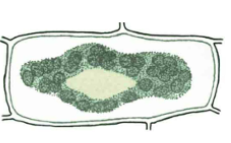
Q-14 The figure given below is a diagrammatic representation of a part of the cross section of the root in the root hair zone. Study the same and then answer the questions that follow:
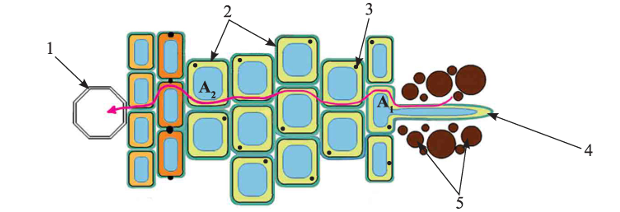
Q-15 The diagram represents a structure found in leaf. Study the same and answer the questions that follow:
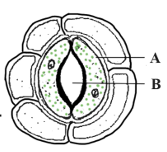
(d) Mention two structural features of A which help in the function mentioned in (c)
Q-16 Given alongside is the diagram of an experiment just at the start. Study the diagram carefully and answer the following questions:
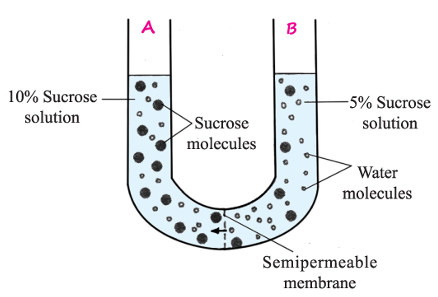
(e) Which limb of the U-tube (A or B) is functionally comparable to the root hairs of a plant?
(f) Redraw the diagram to show the result of the experiment after a few hours.
(v) Which limb of the U-tube (A or B) is functionally comparable to the root hairs of a plant?
Chapter-4 Transpiration
Q-1 Choose the correct option from the brackets.
Q-2 State whether the following statements are true or false:
Q-3 State how the following plants are adapted to reduce transpiration.
Q-4 Answer the following questions.
Q-5 Explain briefly:
Q-6 The apparatus shown is used to study a certain experiment on transpiration.
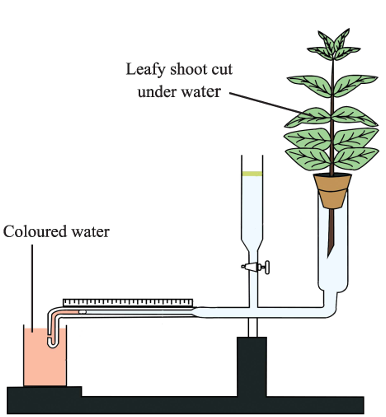
Q-7 The diagram alongside shows a portion of the internal tissues of a xerophytic leaf.
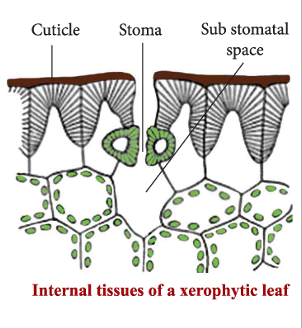
Q-8 Answer these Questions.
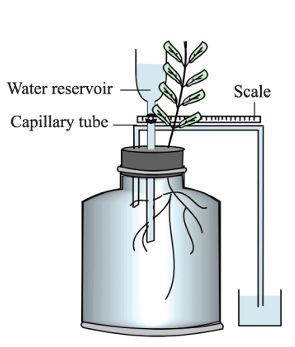
Q-9 The diagram represents a certain physiological process in plants:
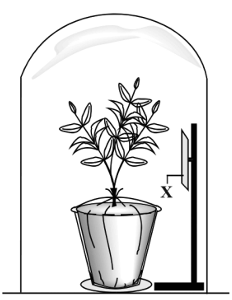
Q-10 This is an experimental set up to study the process of transpiration in plants. Answer the questions that follow:
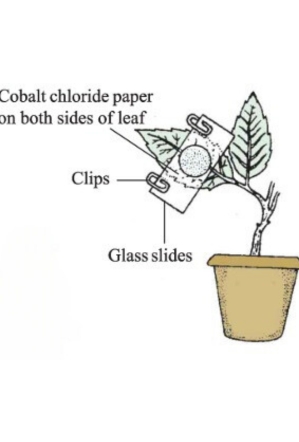
Q-11 And answer the questions based on the given diagram:
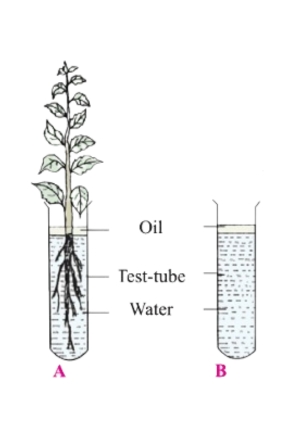
Multiple Choice Questions
Q-1 Transpiration is the loss of water in the form of water vapour from:
(i)
Any surface of the plant body(ii)
Stomata of leaves(iii)
Aerial parts of a plant body(iv)
All of the aboveQ-2 Transpiration pull is maximum when:
(i)
Stomata is open, soil is moist, air is dry(ii)
Stomata is closed, soil and air are dry(iii)
Stomata is open, air and soil are moist(iv)
Stomata is open, soil is dry, air is moistQ-3 Transpiration takes place:
(i)
During the day(ii)
During the night(iii)
During day and night(iv)
As long as the stomata are openQ-4 Which of these is not an anatomical adaptation to reduce excessive transpiration :
(i)
Leaves are rolled up or shed(ii)
Leaves have multiple epidermis(iii)
Leaves have sunken stomata(iv)
Leaves have cutinised hairQ-5 Which of the following is NOT TRUE about transpiration?
(i)
Transpiration brings rain(ii)
Transpiration cools the plant(iii)
Still air increases rate of transpiration(iv)
Transpiration enables ascent of sapChapter-5 Photosynthesis
Q-1 Fill in the blanks:
Q-2 Complete the following by filling in the blanks numbered (i) to (x) with the appropriate word/term:
Q-3 Fill in the blanks (i) to (v) with appropriate words/terms/phrases:
Q-4 Answer the following questions.
Q-5 Experiments based on photosynthesis are followed by the starch test performed on the leaves. The procedure for the starch is described below. State the reason for carrying out each
Q-6 An experiment was set up as explained below.
A cut leafy shoot was placed in a beaker containing water and placed under a bell jar. A lighted candle was also introduced inside the jar. After the candle was extinguished, the entire apparatus was placed in sunlight.
Q-7 State whether the following statements are true or false.
Q-8 Answer the following questions.
A healthy potted geranium plant with variegated leaves was watered and left in the sunlight for several hours. A leaf was then plucked and tested for starch. It was found that a part of the leaf had starch, but the other had no starch.
Q-9 Explain the following:
Q-10 Describe the main chemical changes which occur during photosynthesis in:
Q-11 Name the following:
Q-12 State the following:
Q-13 An experiment was set up as shown below to show that oxygen is evolved during photosynthesis.
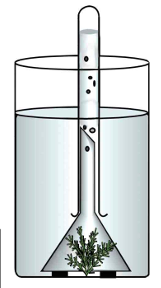
Q-14 The diagram represents a diagrammatic section through part of a leaf.

Q-15 Two healthy green plants were placed in the dark for 24 hours. They were then set up as shown in the figure and left for 4 hours. A leaf was taken from each plant and the chlorophyll was removed from the leaves.
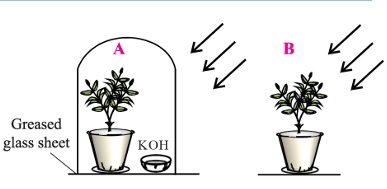
Q-16 A healthy potted geranium plant with variegated leaves was watered and left in the sunlight for several hours. A leaf was then plucked and tested for starch. It was found that a part of the leaf had starch, but the other had no starch.
Q-17 The setup represents an experiment conducted to prove the importance of a factor in photosynthesis. The entire apparatus was placed in a dark room for 48 hours before being kept in sunlight.
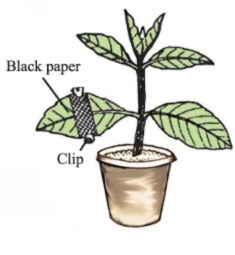
Multiple Choice Questions
Q-1 The rate of photosynthesis is not affected by
(i)
Light intensity(ii)
Carbon dioxide concentration(iii)
Humidity(iv)
Atmospheric pressureQ-2 The water formed during photosynthesis:
(i)
is the original soil water(ii)
is reformed during the chemical reactions(iii)
is formed from atmospheric moisture(iv)
none of theseQ-3 In photosynthesis the catalyst is:
(i)
Sunlight(ii)
Chlorophyll(iii)
Carbon dioxide(iv)
All of theseQ-4 Starch and not glucose is used as a measure of photosynthesis because:
(i)
Glucose is immediately used up by the plan(ii)
Glucose is immediately converted into starch and temporarily stored in leaves.(iii)
Starch is soluble in water.(iv)
Starch is the immediate product of photosynthesis.Chapter-6 Chemical Coordination in Plants
Q-1 Give one term for the following:
Q-2 Fill in the blanks:
(xvi)___________ would cause the stem to grow towards a source of light.
(xii) Promotes stem elongation and enzyme production in seeds.
(xiii) To prevent over ripening, banana should be given a dip in ________ acid.
Q-3 Plant roots are attracted towards moisture.
Q-4 State the role of auxins in the following:
Q-5 What is a meristem? Where are the following meristems located and what is their role?
Q-6 Explain briefly:
(iii) Abscisic acid causes stomata closure.
Q-7 Explain the advantage of the following processes or substances to plants:
Q-8 State whether the following statements are true or false. Correct the incorrect statement.
Q-9 Study the table based on the key functions of plant hormones and answer the questions that follow.
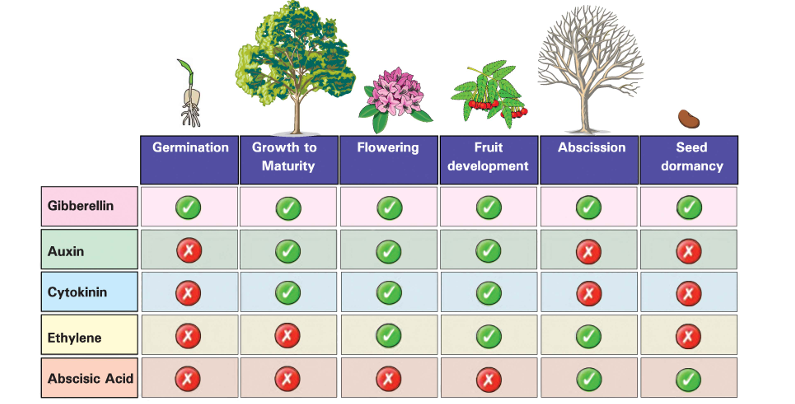
(d) Which hormone is capable of suppressing the stimulatory effect of growth processes of the plant hormones named in (a)? What are such hormones called?
Q-10 The drawings A, B and C shown are of three separate experiments performed to test the effect of a certain plant hormone on the growth of plant shoots.

Q-11 The drawings show a root that has bent downwards and a shoot that has bent upwards.
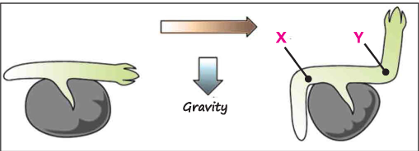
Q-12 Study the diagram and answer the questions:
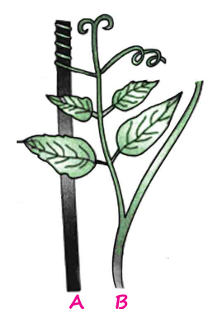
Chapter-7 The Cardiovascular System
Q-1 Differentiate between (one significant difference):
Q-2 State the site (location) and function of the following:
Q-3 Answer the following questions
(1) What are the sounds "LUBB" and "DUPP" produced during a heartbeat?
Q-4 Name the blood vessel that:
(a) Begins and ends in capillaries.
(b) Supplies blood to the walls of the heart.
Q-5 Distinguish between the following pairs on the basis of features indicated in brackets.
Q-6 Answer the following
Q-7 Distinguish between the following pairs on the basis of features indicated in brackets.
Q-8 Differentiate between the following:
Q-9 Explain the following terms:
Q-10 State one similarity and one difference between the following pairs.
Q-11 Without conducting any microscopic examination, how can you determine whether a cut vessel is a/an
Q-12 Explain the following terms:
Q-13 Name
Q-14 The diagram represents a blood smear.
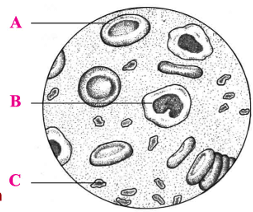
Q-15 Study the figures A, B and C shown below and answer the questions that follow:

Q-16 The diagram represents a mammalian heart.
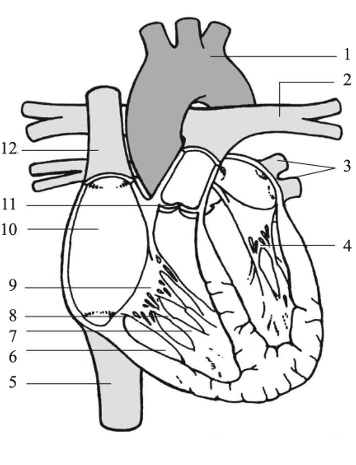
Q-17 Given below is a schematic representation of the circulatory system in humans. Study the same and answer the questions that follow:
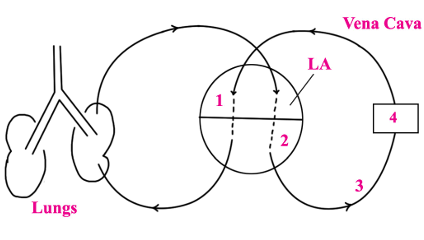
Q-18 The diagrams given alongside show the cross section of three kinds of blood vessels, A, Band C.

Q-19 Given alongside is a simple diagram of the circulation of blood in a mammal showing the main blood vessel, the heart, the lungs and the body tissues. The blood vessel labelled 6 contains deoxygenated blood and the valve leading to it has three semilunar pockets.
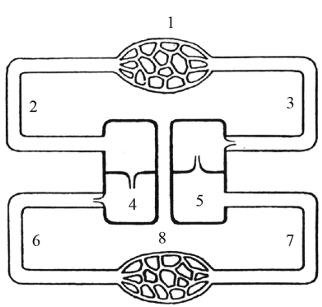
Q-20 The diagram below shows part of the capillary bed in an organ of the mammalian body. Some of the blood arriving at the capillaries at points labelled A moves out into the spaces between the tissue cells. Study the diagram and answer the questions that follow:
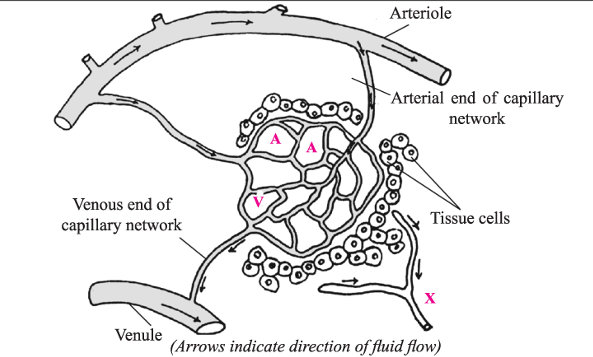
Chapter-8 The Excretory System
Q-1 Answer the following questions
(1) Define excretion.
(2) Name any three excretory organs and also the substances excreted by the named organs.
(3) Name three organic and three inorganic constituents of the glomerular filtrate.
(4) Name three substances that are reabsorbed from the renal tubules by the secondary capillaries.
(5) Draw a neatly labelled sketch of the kidney as observed in longitudinal section.
(6) Name four organs of excretion and list the products excreted by each.
Q-2 Differentiate between the following pairs:
Q-3 Explain briefly:
Q-4 Briefly explain the following terms:
Q-5 State one function of:
Q-6 State whether the following statements are true or false:
Q-7 Correct the following statements by changing only one word:
Q-8 Arrange the terms in the correct sequence.
Q-9 Write the approximate values of the following:
(i) PH of normal urine in adults.
Q-10 Name the following:
Q-11 Study the diagram below and answer the following questions:
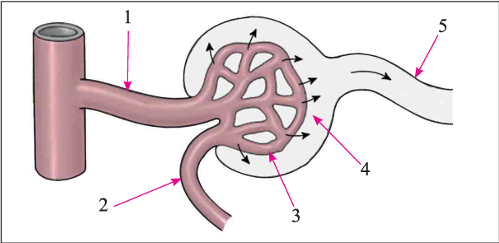
Q-12 Given below is a simple diagram of the human kidney cut open longitudinally.
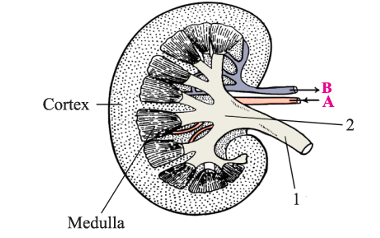
Q-13 Given alongside is the figure of certain organs and associated parts in the human body. Study the same and then answer the questions that follow:
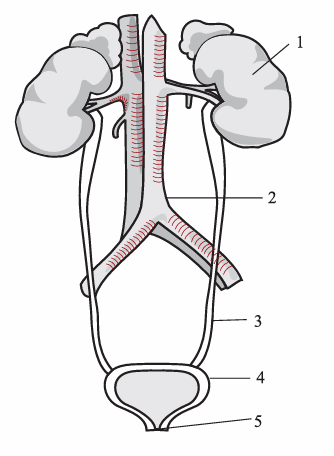
Q-14 Label the parts indicated by arrows and answer the questions that follow:
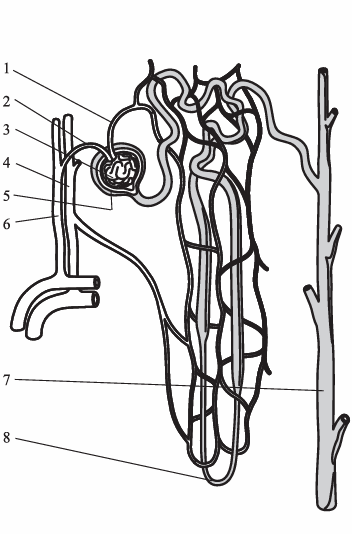
Chapter-9 The Nervous System and Sense Organs: Eye and Ear
Q-1 Answer the following questions
(1) Name two kinds of nerve cells and state the function of each.
(2) Name one neurotransmitter.
(3) What is the nature of an impulse?
(4) Draw a labelled diagram of a myelinated neuron.
(5) Draw a labelled diagram of a myelinated neuron.
Q-2 Explain the role of the following:
Q-3 In which part of the brain are the following located? Also state its functions:
Q-4 Differentiate between the following pairs on the basis of what is given in brackets:
Q-5 Define accommodation of the eye and answer the questions that follows:
Q-6 Jai puts his hand on a nail. He quickly withdraws his hand and shouts in pain.
(a) What type of nervous system is involved when Jai withdraws his hand?
Q-7 Complete the following sentences
Q-8 State whether the following statements are true or false. Correct the incorrect statements:
Q-9 Before crossing the road you look to either side of the road and then walk across if there is no risk or danger involved. Select the part/s involved in this process:
Q-10 Name or give the biological term/technical term for the following:
Q-11 Study the diagram shown alongside and answer the following questions:

Q-12 The diagram shown represents the human brain as seen in an external view. Study the same and then answer the question that follow:
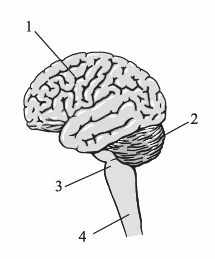
Q-13 Answer the following questions.
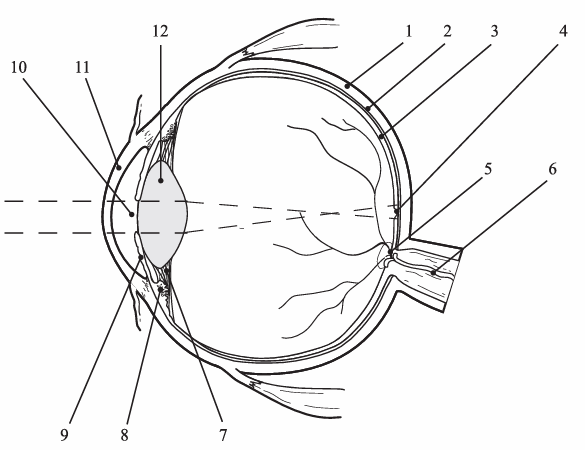
Q-14 Answer the following questions.
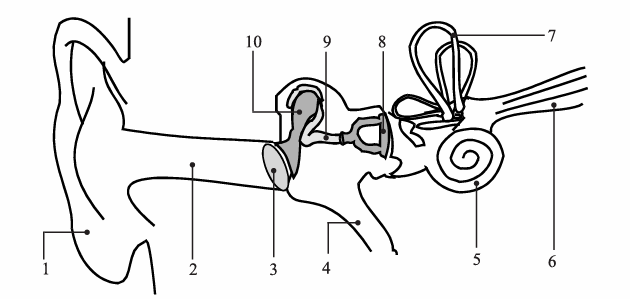
Q-15 Given alongside is the diagram of a part of the human ear. Study the same and then answer the questions that follow:
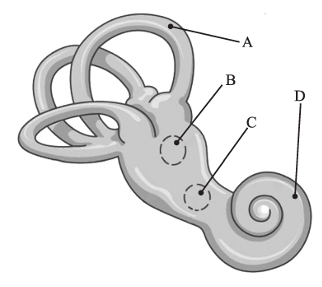
Q-16 Study the diagram given alongside and do as instructed.
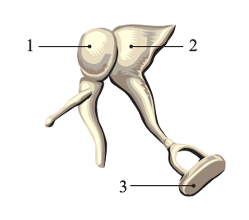
Chapter-10 The Endocrine System
Q-1 Differentiate between:
Q-2 Answer the following questions
(1) Name three organs that are endocrine as well as exocrine in function. Also name their endocrine secretions.
(2) State three characteristics of hormones.
Q-3 Explain briefly:
Q-4 What would be the effect produced if:
Q-5 State one visible effect of:
Q-6 How do the following body parts respond to a surge of adrenal, and what is the sensation produced?
Q-7 Answer the following questions:
Q-8 State the cause and visible symptom that characterises the following conditions:
Q-9 Name the condition described below:
Q-10 Complete the following paragraph by filling in the blanks (i) to (v) with appropriate words:
Chapter-11 The Reproductive System
Q-1 Fill in the blanks:
Q-2 Fill in the blanks:
Q-3 Answer the following questions
(4) Name two substances that diffuse into, and two substances that diffuse out of the placenta.
(5) State three functions of the placenta.
Q-4 Explain briefly:
Q-5 Give a biological term for the following:
Q-6 Name the gland or part, and the hormone secreted by it during the menstrual cycle which:
Q-7 Complete the following sentences by choosing the correct alternative out of those given in the brackets.
Q-8 State whether the following statements are true or false.
Q-9 Name:
Q-10 Name the gland or part, and the hormone secreted by it during the menstrual cycle which:
Q-11 Label the parts 1 to 11 in the diagram given below.
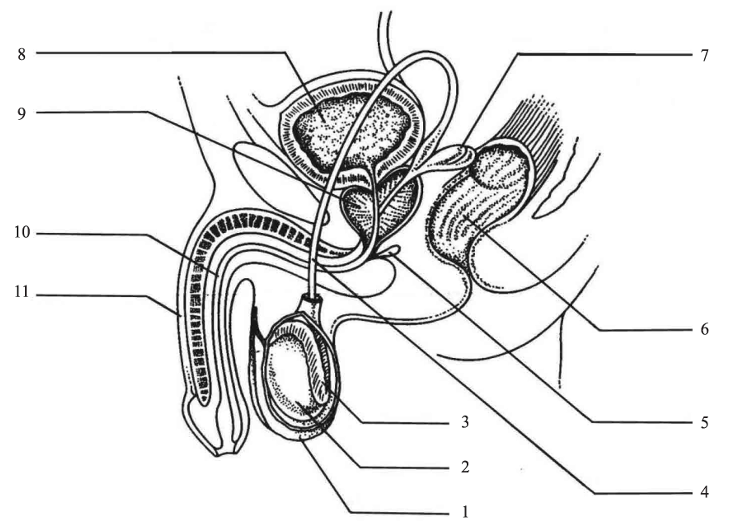
Q-12 Label the parts 1-9 in the diagram given below.
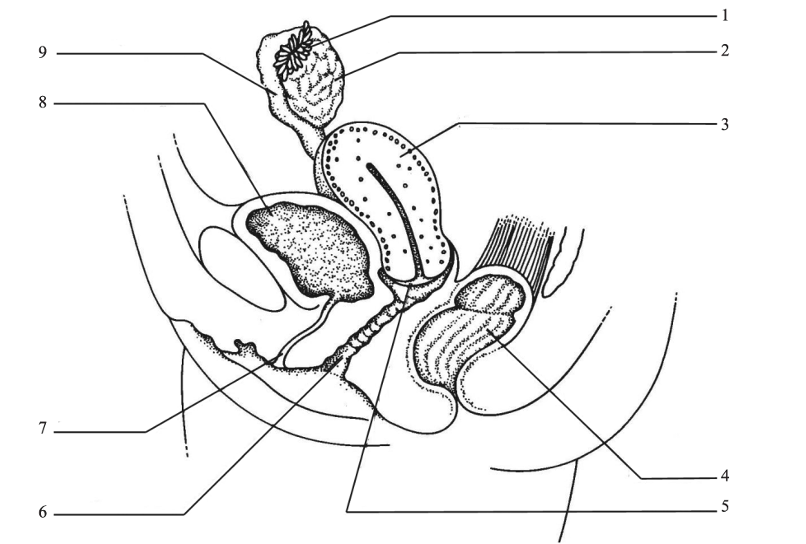
Q-13 Given alongside is the outline of the male urogenital system:
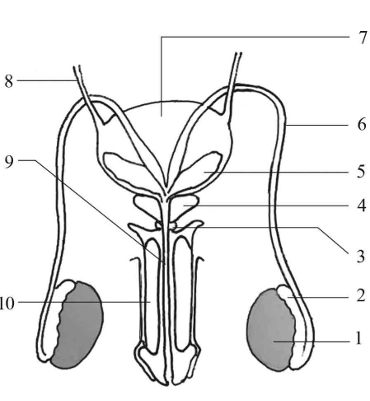
Q-14 Label the following parts in the structure shown alongside:
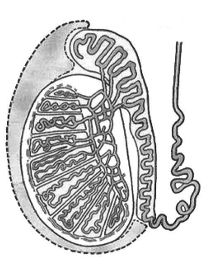
Q-15 Given alongside is a diagrammatic representation of the ventral sectional view of the female reproductive system.
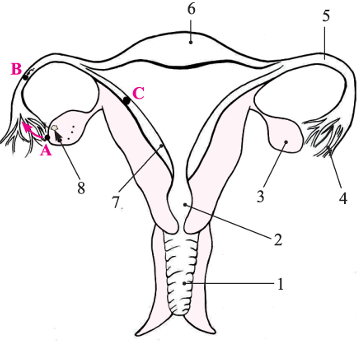
Q-16 Study the structure shown and answer the questions:

Q-17 The figure shown represents a medical procedure.
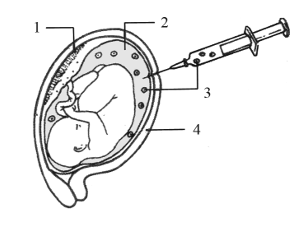
Chapter-12 Human Evolution
Q-1 Answer the following questions
(1) What is meant by evolution?
(2) According to the theory of evolution, changes in environment may cause an organism to develop various adaptations. Support this statement with a suitable example.
(3) Briefly state and explain the three main ideas contained in Lamarck's theory of evolution.
(4) Briefly state and explain the three main ideas contained in Lamarck's theory of evolution.
(5) What are vestigial structures?
(6) Explain the significance of vestigial structures despite the fact that they have no function to perform in the current organism.
(7) Mention three characteristics that account for the superiority of primates over all other animal groups.
(8) Mention any five structural limitations of the human body.
(9) Mention the general characteristics of the Australopithecine Skull.
Q-2 Name the scientists associated with the following theories:
Q-3 Explain the long neck of the present day giraffe on the basis of:
Q-4 Explain briefly the following:
Q-5 The transition from quadruped to biped required important physical changes. In this context explain the following modifications:
Q-6 Fill in the blanks by selecting the correct alternative.
Q-7 Explain the evolutionary advantage of the following features of human beings:
Q-8 State whether the following statements are true or false . Correct the incorrect statements.
Multiple Choice Questions
Q-1 The first form of human like creature appeared more the 4 million years ago in:
(i)
Africa(ii)
Asia(iii)
Europe(iv)
America
Q-2 Which is NOT a hominid feature?
(i)
Upright posture(ii)
Bipedal locomotion(iii)
Construction and use of tools(iv)
Small brain and large teeth
Q-3 The chronological order of human evolution from early to the recent is:
(i)
Homo sapiens ➔ Australopithecus ➔ Homo habilis ➔ Homo erectus ➔ Homo sapiens sapiens(ii)
Australopithecus ➔ Homo habilis ➔ ➔ Homo erectus ➔ Homo sapiens ➔ Homo sapiens sapiens(iii)
Australopithecus ➔ Homo erectus ➔ Homo sapiens ➔ Homo sapiens sapiens➔ Homo habilis(iv)
Homo habilis ➔ Homo sapiens ➔ Homo erectus ➔ Homo sapiens sapiens ➔ Australopithecus
Q-4 Which is NOT a feature of Australopithecus:
(i)
Body covered with hair(ii)
Bipedal(iii)
Prominent chin(iv)
Flat face with brows projecting over the eyes
Q-5 Which of the following is not an ape?
(i)
Chimpanzee(ii)
Orangutan(iii)
Gorilla(iv)
Monkey
Q-6 Which one of the following changes did not contribute to the transition from quadraped to biped?
(i)
Legs became longer than arms.(ii)
The pelvis became shorter.(iii)
Loss of tail.(iv)
The sole of the feet became arched.Chapter-13 Population
Q-1 Answer the following questions
(1) What is the present rate of growth of population of the world and of India?
(2) List three major landmarks in human history which contributed to sudden rise in the population of the world.
(3) What is the approximate Indian population according to the 2011 census?
(4) Explain the term "Growth rate of population". In what situation can it be negative?
(5) What is the popular sign for family planning and family welfare in India?
(6) Mention two reasons for the decline in death rate in India in recent times.
(7) List the advantages of having small families.
(8) What are the main drawbacks of a large population?
(9) Account for the high birth rate in India.
(10) What are the age restrictions for marriage by law for boys and girls in India?
(11) What are the main objectives of the Family Welfare Program?
(12) What steps has the Indian Government taken to control population?
(13) Name any two methods of birth control.
(14) Population grows exponentially. Explain what is meant by this statement.
(15) Justify the statement "Our reserves cannot keep pace with rising population" with two examples.
Q-2 Define:
Q-3 Give the biological term/technical term for the following:
Q-4 Match the items given in Column I with those of Column II

Chapter-14 Pollution
Q-1 Answer the following questions
(1) Define pollution.
(2) List any three pollutants of each - water, air and soil.
(3) Environmental pollution is the by-product of modern civilisation. Comment.
(4) State the factors that affect air pollution in a particular area.
(5) How do tall buildings in a city cause temperature inversion?
(6) What effect does bio-medical waste accumulation have on the environment?
(7) How do oil spills affect marine life?
(8) State two local and two global effects of air pollution.
(9) Describe the sources of land pollution.
(10) How do fertilisers and pesticides cause soil pollution?
(11) State four general methods of controlling air pollution.
(12) State four measures of proper traffic management that can help reduce air pollution.
(13) 'Prevention is better than cure' . Give two examples to illustrate the statement in the context of air pollution.
(14) Briefly explain how air pollution has become a serious obstacle in the socio-economic development of a country.
(15) Explain - 'Alternative fuel'. What advantages do these fuels have over traditional fossil fuels?
(16) What is nuclear waste? How should it be disposed?
(17) During festivals people should exercise restraint and reduce noise. Suggest some more measures to combat noise pollution in cities.
Q-2 Write short notes on:
Q-3 Name:
Q-4 Explain the following:
Q-5 State two harmful effects of each of the following:
Q-6 Most of the gases and particles that people put into the air come from combustion processes.
Q-7 In many large cities of India, vehicular pollution is the chief culprit of air pollution:
Q-8 What is Acid Rain? State the harmful effects of acid rain to each of the following:
Q-9 Suggest measures to control the following gaseous pollutants:
Q-10 State three ways each to control:
Q-11 Write a short note on each of the following:
Multiple Choice Questions
Q-1 A device used in the chimney to remove solid particles from the gases released in the air:
(i)
stainer(ii)
electrostatic precipitator(iii)
cloth(iv)
converter
Q-2 The smog is formed due to:
(i)
dust and fog(ii)
smoke and fog(iii)
CO2 and fog(iv)
Sun and fog
Q-3 Eutrophication leads to death of fish due to:
(i)
decreased 0 2 concentration(ii)
increased algal growth(iii)
increased CO2 concentration(iv)
increased 0 2 concentration
Q-4 Soil erosion is mainly caused due to:
(i)
wind(ii)
cutting of trees(iii)
overuse of fertilisers(iv)
poor irrigation
Q-5 Large amounts of mercury is released into the air during the manufacture and disposal of:
(i)
glass(ii)
dry cells(iii)
cement(iv)
television
Q-6 Decibel (dB) is the unit of measuring:
(i)
water pollution(ii)
noise pollution(iii)
air pollution(iv)
soil pollution
Q-7 A device used to convert harmful gases from the automobiles:
(i)
filter pump(ii)
break shoes(iii)
catalytic converter(iv)
precipitator
Q-8 A gas emitted from the oil refinery causes nausea, dizziness and in large amount causes death:
(i)
sulphur dioxide(ii)
carbon dioxide(iii)
hydrogen sulphide(iv)
nitrogen dioxide
Q-9 A natural method to get rid of oil slicks from the marine water:
(i)
algae(ii)
fish(iii)
bacteria (Pseudomonas)(iv)
detergents
Q-10 Which of the following is not a greenhouse gas:
(i)
ammonia(ii)
nitric oxide(iii)
methane(iv)
carbon dioxide